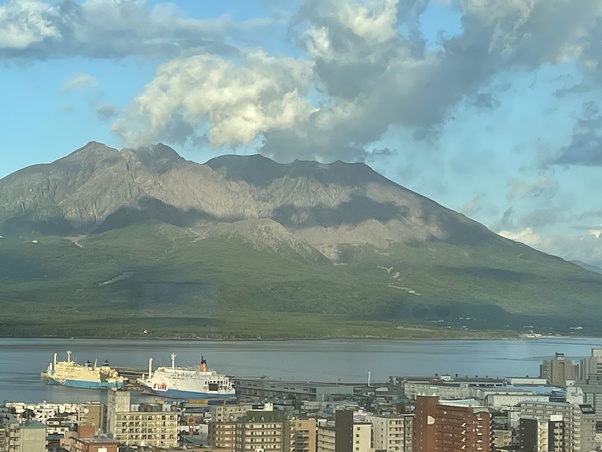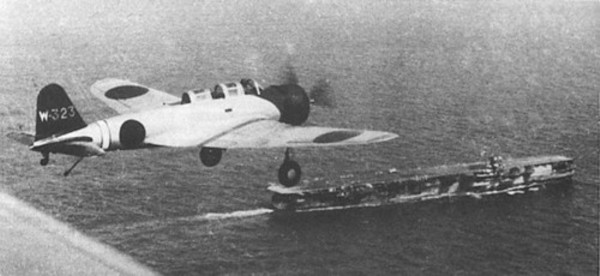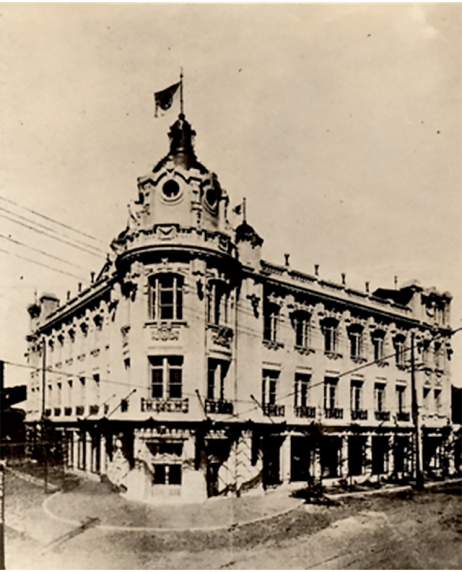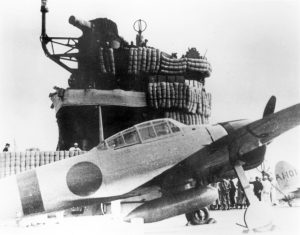Five months before Pearl Harbor, Japanese Admiral Yamamoto Isoroku ordered his subordinate, Ohnishi Takijiro, to commence training for their planned attack on the U.S. naval base of Pearl Harbor in Hawai’i. The two men realized that their biggest challenge in the training would be to have their torpedo bomber pilots learn to execute an attack that called for them to fly over tall mountains, then drop to execute an extremely low level attack in a crowded bay.
Yamamoto had planned a surprise attack on Pearl Harbor. It needed to be kept a secret. Therefore, it was perhaps surprising that Yamamoto decided to have his torpedo pilots train in plain sight, with hundreds of thousands of people watching. The location he chose was the southern port city of Kagoshima.

Kagoshima harbor in 2023, looking from the city across to the active volcano on the island of Sakurajima. Photo by Ronald Drabkin.
Kagoshima, located on the tip of the southern island of Kyushu, is famous for being a warlike city. The feudal lords of Kagoshima, the Shimazu clan, had conquered Okinawa, gotten into a shooting war with British warships in the 1850s, and had led the armies that overthrew the Shogun and restored the Emperor to power in the late 1800s.
The reason Yamamoto chose Kagoshima was because it was quite similar to Pearl Harbor, and therefore gave his pilots very realistic training. Kagoshima, like Honolulu, is a medium-sized city surrounded by mountains. The mountains in both areas drop away to reveal the city on a small plain and a shallow bay.
The pilots would therefore need to practice flying over high mountains, then drop down to altitude of just 10 meters at high speed, and then release their torpedoes while flying just over the water. At Pearl Harbor, they would likely need to do this under anti-aircraft fire. There were hundreds of planes, so they would need to ensure they didn’t crash into each other in the crowded environment. They would also be so low they were at risk of hitting a fishing boat in the bay or a tall building in Kagoshima, such as the seven-story Yamagataya department store. Just a momentary slip in concentration could have them crashing into the water.

A Nakajima “Kate” torpedo bomber of the type used in practice at Kagoshima and in the Pearl Harbor attack. Source: Wikimedia Commons
The torpedoes had been engineered so that they could work in just 40 feet of water, but to do so, they needed to be dropped at very low height, or else gravity would likely see the torpedoes drop down and detonate uselessly against the seafloor. Much has been written about the technical challenges of making torpedoes run at shallow depths, but that had already been accomplished, so Yamamoto’s focus was training the pilots to use them properly in this challenging environment.
Training for the other parts of the attack – the level bombing and the mini submarines – was done in more isolated areas.
Japanese accounts of Kagoshima downplay the risk of Americans noticing or catching wind about what the Japanese torpedo planes were practicing. Japanese novels and TV shows have perpetuated the story that, back in the feudal area, the daimyo rulers of the area created a secret language to prevent infiltration from spies from the Shogun in Tokyo. Modern linguists have refuted this assertion, simply saying that the isolated location evolved a very strong dialect that was not understandable to outsiders. However, secretive or not, with hundreds of thousands of people watching the torpedo practice, the chance of word getting out was nontrivial.
The torpedo practice was done in a very realistic fashion, with the airplanes flying at a shockingly low altitude of 10 meters over the bay and the town. The Japanese aviators reported that they practiced “Monday, Monday, Tuesday, Wednesday, Thursday, Friday, and Friday” (a clever way of saying they practiced seven days a week).

The Yamagataya department store in Kagoshima in the early Showa period. The building was larger than the others in the town, so the torpedo planes needed to ensure they didn’t hit it as they practiced their low level attacks. Source: The Yamakata Company
Kagoshima University’s oral histories have recorded what the citizens thought. Once they got over their initial shock, many waved their small Japanese flags bearing the dazzling red rising sun at the pilots flying just over their heads. Awestruck spectators were recorded as saying:
“We didn’t know there were that many airplanes in all of Japan.”
“The planes flew so low that we could smell the burning gasoline from their engines.”
The fishermen in the bay were initially hesitant to say anything, but comments came into the Navy complaining the low-level flying was “scaring away the fish” and even that a couple of sailboats had been capsized from planes flying directly overhead.
The planes were clearly practicing torpedo bombing, coming in low, dropping their payloads, and then flying away. Did any Americans notice it? Somehow, it doesn’t appear so.
In the book “Pearl Harbor: Betrayal, Blame, and a Family’s Quest for Justice,” Anthony Summers and Robbyn Swan show that the British torpedo plane attack on the Italian Navy in the port of Taranto was similar to Pearl Harbor in execution, with the British executing a surprise attack that sank a couple of Italian battleships. Further, they note Germans, Japanese, and even a U.S. Naval Intelligence officer had looked into this attack to see what they could learn. Taranto harbor is also shallow, like Kagoshima and Pearl Harbor, proving that a torpedo attack in a shallow harbor could work. But there was no evidence found showing that the U.S. Navy did anything with that information.
Edwin Layton, the U.S. Navy intelligence chief in Hawaii on December 7, wrote an excellent book on Pearl Harbor and Midway called “And I Was There.” He discusses Yamamoto’s preparation as background. A glaring indicator that the United States didn’t notice Yamamoto’s practice for Pearl Harbor is that Layton’s book gets all the locations of the practice wrong. He wrote that Kagoshima is in Honshu, which is a totally different island, and that the Japanese level bombing practice was done from Kanoya, at the tip of Kyushu, which it is not.
Yamamoto had bet he could train his aviators in plain sight, without alerting the Americans – and history proves that he was indeed right.
This article is adapted from a chapter in the author’s newly published book, “Beverly Hills Spy: The Double-Agent Flying Ace Who Infiltrated Hollywood and Helped Japan Attack Pearl Harbor.”

































